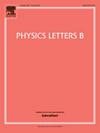A bound on light dark photon dark matter
IF 4.3
2区 物理与天体物理
Q1 ASTRONOMY & ASTROPHYSICS
引用次数: 0
Abstract
We derive a bound on dark photon dark matter scenarios where the dark photon mass is generated through the Higgs mechanism, based on the requirement that symmetry breaking must occur sufficiently early in the universe. We emphasize that dark photon production occurs successfully when the dark Higgs field remains in the symmetric phase due to non-thermal trapping effects. For renormalizable Higgs potentials, our bound reads where is the dark photon mass, is the gauge coupling, is the charge of the dark Higgs boson, and λ is the Higgs quartic coupling. This constraint holds independently of any complications arising from the Schwinger effect and vortex formation in the Higgsed phase. For more general Higgs potentials such as the Coleman-Weinberg type potential, our bound yields different forms. We argue that late-time symmetry breaking of the dark U(1) symmetry satisfying our bound has only a mild impact on both the abundance and momentum distribution of dark photon dark matter, and therefore does not pose any serious problem for the dark photon dark matter scenario.
求助全文
约1分钟内获得全文
求助全文
来源期刊

Physics Letters B
物理-物理:综合
CiteScore
9.10
自引率
6.80%
发文量
647
审稿时长
3 months
期刊介绍:
Physics Letters B ensures the rapid publication of important new results in particle physics, nuclear physics and cosmology. Specialized editors are responsible for contributions in experimental nuclear physics, theoretical nuclear physics, experimental high-energy physics, theoretical high-energy physics, and astrophysics.
 求助内容:
求助内容: 应助结果提醒方式:
应助结果提醒方式:


